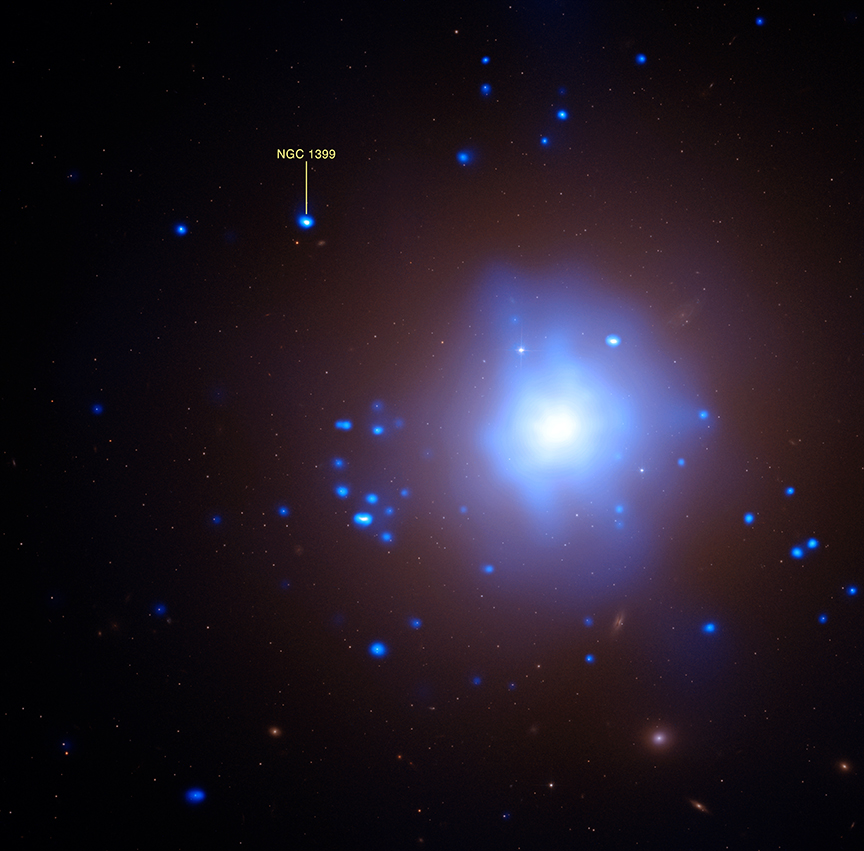|
Black Holes |
|
|
01.04.10 ..
New results from NASA's Chandra X-ray Observatory and the Magellan telescopes suggest that a dense stellar remnant has been ripped apart by a black hole a thousand times as massive as the Sun. If confirmed, this discovery would be a cosmic double play: it would be strong evidence for an intermediate mass black hole, which has been a hotly debated topic, and would mark the first time such a black hole has been caught tearing a star apart. This scenario is based on Chandra observations, which revealed an unusually luminous source of X-rays in a dense cluster of old stars, and optical observations that showed a peculiar mix of elements associated with the X-ray emission. Taken together, a case can be made that the X-ray emission is produced by debris from a disrupted white dwarf star that is heated as it falls towards a massive black hole. The optical emission comes from debris further out that is illuminated by these X-rays. The intensity of the X-ray emission places the source in the "ultraluminous X-ray source" or ULX category, meaning that it is more luminous than any known stellar X-ray source, but less luminous than the bright X-ray sources (active galactic nuclei) associated with supermassive black holes in the nuclei of galaxies. The nature of ULXs is a mystery, but one suggestion is that some ULXs are black holes with masses between about a hundred and several thousand times that of the Sun, a range intermediate between stellar-mass black holes and supermassive black holes located in the nuclei of galaxies. This ULX is in a globular cluster, a very old and crowded conglomeration of stars. Astronomers have suspected that globular clusters could contain intermediate-mass black holes, but conclusive evidence for this has been elusive. "Astronomers have made cases for stars being torn apart by supermassive black holes in the centers of galaxies before, but this is the first good evidence for such an event in a globular cluster," said Jimmy Irwin of the University of Alabama who led the study. Irwin and his colleagues obtained optical spectra of the object using the Magellan I and II telescopes in Las Campanas, Chile. These data reveal emission from gas rich in oxygen and nitrogen but no hydrogen, a rare set of signals from globular clusters. The physical conditions deduced from the spectra suggest that the gas is orbiting a black hole of at least 1,000 solar masses. The abundant amount of oxygen and absence of hydrogen indicate that the destroyed star was a white dwarf, the end phase of a solar-type star that has burned its hydrogen leaving a high concentration of oxygen. The nitrogen seen in the optical spectrum remains an enigma. "We think these unusual signatures can be explained by a white dwarf that strayed too close to a black hole and was torn apart by the extreme tidal forces," said coauthor Joel Bregman of the University of Michigan. Theoretical work suggests that the tidal disruption-induced X-ray emission could stay bright for more than a century, but it should fade with time. So far, the team has observed there has been a 35 percent in X-ray emission from 2000 to 2008. The ULX in this study is located in NGC 1399, an elliptical galaxy about 65 million light years from Earth. Irwin presented these results at the 215th meeting of the American Astronomical Society in Washington, DC. NASA's Marshall Space Flight Center in Huntsville, Ala., manages the Chandra program for NASA's Science Mission Directorate in Washington. The Smithsonian Astrophysical Observatory controls Chandra's science and flight operations from Cambridge, Mass. Janet Anderson, 256-544-6162
Megan Watzke 617-496-7998
SOURCE: NASA - Massive Black Hole Implicated in Stellar Destruction
|
|
| FAIR USE NOTICE: This page contains copyrighted material the use of which has not been specifically authorized by the copyright owner. Pegasus Research Consortium distributes this material without profit to those who have expressed a prior interest in receiving the included information for research and educational purposes. We believe this constitutes a fair use of any such copyrighted material as provided for in 17 U.S.C § 107. If you wish to use copyrighted material from this site for purposes of your own that go beyond fair use, you must obtain permission from the copyright owner. | |
|
|

